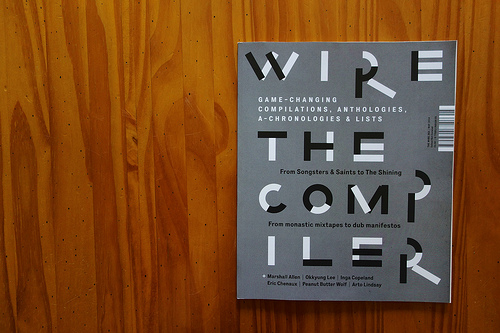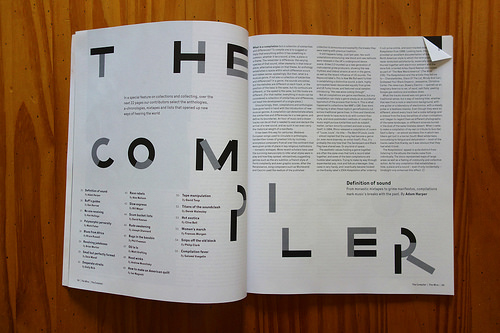Why do I blog this? I'm not necessarily a big brand advocate, nor a fan of Lulu Lemon. However, I'm fascinated by the way their products come with such USP-oriented "why we made this" tags. Obviously, the answers are sometimes so-so (#1 and #3 overlap here) but I would certainly find fascinating to see ANY product around us with similar labelling. It's perhaps an intriguing assignment to ask workshop participants.
Resurgence of early software?
Currently reading “Software Takes Command” by Lev Manovich, i’m fascinated by the part where he explains the lack of interest about the history of cultural computing by our cultural institutions and computer industry itself. He explains that a possible reason for this lies in the absence of profits from the old software by current companies, unlike, say, Hollywood which "continues to receive profits from old movies as it reissues them in new formats (VHS, DVD, HD, Blu-ray disks, etc)”. The most intriguing part corresponds to this affirmation that I find super intriguing:
"given that consumer culture systematically exploits adults’ nostalgia for the cultural experiences of their teenage and youth years, it is actually surprising that early software versions were not seen as a market opportunity.”
I guess that’s quite common in the video game industry, see for instance the release of yet-another-version of Eric Chahi’s Another World, but what about other types of software ? What would that entail ? Which software would you pick?
Why do I blog this? Thats looks like a good design fiction angle, and alternatively, a curious assignments for marketing students: how would you sell the resurgence of Quark X Press and Mac Paint ?
"my son has limited screen time so he plays @PlantsvsZombies on paper" says Boian Tzonev in an insightful tweet.
Paper-based video games
At some point, I'll have to investigate this. A phenomenon that always fascinates me: how players use paper as a (brick-and-mortar?) substitute to video games when devices are not available, or as a complement (for taking notes, drawings maps, etc.).
Another example of paper video game found on boing boing
Why do I blog this? This is definitely fascinating. Not just because you see kids' fantasies and ways to change mediums. It's intriguing because it reveals how a game mechanic, or a graphic pattern, circulates and mutates to create a curious experience. I've seen once kids playing together on paper and I enjoyed observing how they "filled the gap", how the absence of the mighty computer was turned into creative engine.
Plus, I find this interesting because it obviously leads to curious game design propositions, and bc it makes me think of how to take this into consideration in video game design itself: how would you enable the other persons around a player to use paper to improve the game? Can one create a game in which the person holding the controller needs a friend to use a hand-drawn map to help her?
Besides, no one here thought of booklets with video game grids, Zelda open world maps in B&W versions, Super Mario Sunshine levels... with weird paper game mechanics so that players can "interact" with them? I'm pretty sure this exist. The Star Wars starfighter battle book series is a good start but still...
Update: another curious example found here, it looks like UX prototyping.
Visualizing TV series
This month, I'm giving a workshop at HEAD–Genève with Frédéric Kaplan and Yannick Rochat about Information Visualization and TV-series. The idea is to show the students how to visually depict events, characters' network, geographical evolution, among other things in these shows... using various sources (scripts found in imsdb, subtitles, Wikipedia entries fan encyclopedia like wookiepedia, etc.). Some examples below we discussed in class:
ALL ABOUT TV SERIES by DH101 students EPFL
Production of various visualizations, like the one below (Game of Thrones)
TWIN PEAKS 1990 on moviegalaxies
LORD OF THE RINGS PROJECT by Emil Johansson
CORE-SAMPLE by Aurelien Farina:
This editorial and artistic project is based on the metaphor of "coring", a technique used for geological and industrial ground surveys. The project was elaborated as an application of the coring technique to a particular mass-culture production : the "Starsky & Hutch" TV series. The book consists in a number of chapters made of screenshots captured in the series' first two seasons (1975-1977) : all recurent scenes are gathered and accumulated in series of similar images.
Core sample
Core sample
Outline
"we need to talk" pages
Why do I blog this? Collecting examples for the coming days of the workshop: types of visualizations (social networks, maps), sort of data proposed (texts, images...), the type of analysis, etc.
"These machines can be a metaphor for whatever's on people's minds."
A dialogue from Mad Men S07E04:
"Lloyd: These machines can be a metaphor for whatever's on people's minds.
Don Draper: Because they're afraid of computers?
Lloyd: Yes. This machine is frightening to people, but it's made by people.
Don Draper: And people aren't frightening?
Lloyd: It's not that. It's more of a cosmic disturbance. This machine is intimidating because it contains infinite quantities of information, and that's threatening, because human existence is finite. But isn't it godlike that we've mastered the infinite? The IBM 360 can count more stars in a day than we can in a lifetime.
Don Draper: But what man laid on his back counting stars and thought about a number?
Lloyd: He probably thought about going to the moon."
Why do I blog this? Just found this dialogue interesting as a metaphor for discussion in the 1960s about "computing" and the role of this machinery in society.
"Pop-up studio" manual
Studio D Radiodurans – Jan Chipchase's new boutique – just released an intriguing booklet called "Pop-up Studio: Designing The Design Experience". It's basically a 43-pages guide that describes "how to run a pop-up studio, when and why it is appropriate, the trade-offs that need to be understood".
Based on various examples coming from Jan and his current/former colleagues, it's full of insightful material for design researchers, field explorers and people interested in product/service/strategy development. The set of tools and the approach explained in this book are meant to show how to manage "rapid immersion" into new cultural forms, people's practices and use that material to surface new ideas and designs. Lots of details are provided about how to do that and what it means practically (studio duration, use of space, budgets, check-lists, ...). It seems like a great companion to the upcoming "the field study handbook".
Why do I blog this? Definitely because I'm interested in others' methods, guidelines, recommendations and informed opinions. It's always good to take them as inspiration and cases to create one's approach. Plus it's related with a current project that aims at describing how designers repurposed ethnography in their own work context (book to be released in few months).
Collection, accumulation, compilation
Coincidentally, I received two magazines today about a similar topic: collection and compilation. The first is the last copy of The Wire, the British music journal; and the second is FACTA, a fascinating Brazilian fanzine about "gambiologia" (the study of creative improvisation and electro-digital DIY).
"What is a compilation but a collection of similarities and differences? To compile is to suggest or imply that everything within it has something in common, whether it be a sound, a time, a place or a theme. The remainder is difference: the varying species of that sound, other elements in that time or place, alternative angles on that themes" describes Adam Harper in his introduction to the special issue of The Wire on compilation.
Why do I blog this? I'm curious about the role of compilation, collection and selection, mostly with regards to the analytical mindset of designers/artists and ethnographers. There's something in common here that should be explored, beyond the type of artifacts and cultural content that is collected. I generally work using aggregation of various types of material and enjoy this type of process. For instance, the game controller project was based on collecting actual game pads that we explored in conjunction with patents, interviews with designers and players, books about the history of video games... the careful compilation of facts, anecdotes, pictures, opinions, statistics and hypotheses created a curious assemblage that helped creating various intermediary objects (diagrams, genealogy trees, installation in exhibits) and two books.
The Smithsonian on Science Fiction, the Future and design fiction
The May edition of the Smithsonian has an article on sci-fi, the Future (capital F) and design fiction. Based on interviews with various science-fiction authors (Kim Stanley Robinson, Cory Doctorow, William Gibson, Ursula Le Guin, Ted Chiang or Neal Stephenson), this piece by Eileen Gunn highlights how the genre acts as a sort of laboratory and "how the task of science fiction is not to predict the future. Rather, it contemplates possible futures."
Interestingly, this article describes classical debates about the mutual relationships between sci-fi, science and technological research: the opposition between utopian and dystopian futures (as well as the acknowledgment that this dualism is flawed), the "where's my flying car?" frustration that some authors want to move away from, the need to embrace new visions of the future, etc. The paper concludes with this sort of summary of the role of science-fiction for society:
Science fiction, at its best, engenders the sort of flexible thinking that not only inspires us, but compels us to consider the myriad potential consequences of our actions. Samuel R. Delany, one of the most wide-ranging and masterful writers in the field, sees it as a countermeasure to the future shock that will become more intense with the passing years. “The variety of worlds science fiction accustoms us to, through imagination, is training for thinking about the actual changes—sometimes catastrophic, often confusing—that the real world funnels at us year after year. It helps us avoid feeling quite so gob-smacked.”
This piece is quite interesting. However, I'm not sure about the current debate on the importance of reading science-fiction in research labs ("Brueckner laments that researchers whose work deals with emerging technologies are often unfamiliar with science fiction.") Of course, I'm convince about Delany's quote above but I'm unsure whether this applies to ANY book, film, video-game or comic-book related with "the Future". Would the Warhammer 40K series of book really help like a JG Ballard novel? Besides, one might also argue that poetry or other forms of literature might be helpful? And why limiting oneself to this? Perhaps there are other ways to get this "flexible thinking" promoted by the authors there: RTS games or Eve-Online situated in a distant future might be relevant too. This problem was recently address in another article in The Atlantic. Robinson Meyer commented on Google's process for selecting Google X projects: "lt must utilize a radical solution that has at least a component that resembles science fiction.", to which the author wrote:
When we imagine a “science fiction”-like future, I think we tend to picture completed worlds, flying cars, the shiny, floating towers of midcentury dreams. We tend, in other words, to imagine future technological systems as readymade, holistic products that people will choose to adopt, rather than as the assembled work of countless different actors, which they’ve always really been. The futurist Scott Smith calls these ‘flat-pack futures,’ and they infect “science fictional” thinking. Science fiction, too, can underestimate the importance and role of social change. For every feminist science fiction writer or Afrofuturist, there is a still better-known member of the genre’s far-right.
Why do I blog this? I'm currently writing a book (French) about these topics, and such articles offer interesting parallel to my current thinking and projects carried out at the Near Future Laboratory.
For people intrigued by such material, these pieces should be read alongside Julian's essay on design fiction, as well as "Better Made Up: The Mutual Influence of Science fiction and Innovation" (Caroline Bassett, Ed Steinmueller, Georgina Voss, Nesta, 2013) and "Imagining Technology" (Jon Turney, Nesta, 2013).
Design fiction: a bibliography
Some resources about design fiction I'm use to share with students. Note that the term itself is polysemic and covers different perceptions about its meaning.
Auger, J. (2011). Alternative Presents and Speculative Futures: Designing fictions through the extrapolation and evasion of product lineages., Negotiating Futures / Design Fictions, Swiss Design Network 2011, Basel.
Auger, J. (2013). Speculative design: crafting the speculation, Digit. Creat., vol. 24, no. 1, pp. 11--35, 2013.
Bassett, C., Steinmuller, E. & Voss, G. (2013). Better Made Up: The Mutual Influence of Science fiction and Innovation”, Nesta Working Paper 13/07.
Bleecker, J. (2009). Design fiction: A short essay on design, science, fact and fiction, Near Future Laboratory, Los Angeles, CA,
Bleecker, (2011). Design Fiction: From Props To Prototypes, Negotiating Futures / Design Fictions, Swiss Design Network 2011, Basel.
Bleecker, J. & Nova, N., (2009). A synchronicity: Design Fictions for Asynchronous Urban Computing. The Architectural League of New York, New York, NY.
Candy, S. (2010). The futures of everyday life: politics and the design of experiential scenarios, PhD thesis. The University of Hawai.
DiSalvo, Carl. (2012). Spectacles and Tropes: Speculative Design and Contemporary Food Cultures. The Fibreculture Journal(20).
Dunne, A. & Raby, F. (2011). Design noir: The Secret Life of Electronic Objects. Basel: Birkhäuser, 2001.
Dunne, A. & Raby, F. (2014). Speculative Everything: design, fiction and social dreaming. MIT Press.
Forlano, L. (2013). Ethnographies from the Future: What can ethnographers learn from science fiction and speculative design?, Ethnography Matters.
Franke, B. (2011). Design Fiction is Not Necessarily About the Future, Negotiating Futures / Design Fictions, Swiss Design Network 2011, Basel.
Galloway, A. (2013). Towards Fantastic Ethnography and Speculative Design, Ethnography Matters.
Grand, S. & Wiedmer, M. (2010). Design Fiction: A Method Toolbox for Design Research in a Complex World, DRS, 2010.
Hales, D. (2013). Design fictions an introduction and provisional taxonomy, Digital Creativity, 24:1, 1-10
Jain, A., Ardern, J. & Pickard, J. (2012). Design Futurescaping, Journal of Futures Studies.
Johnson, B.D. (2009). “Science Fiction Prototypes Or: How I Learned to Stop Worrying about the Future and Love Science Fiction”, in Intelligent Environments 2009 – Proceedings of the 5th International Conference on Intelligent Environments, Callaghan, V., Kameas, A., Reyes, A., Royo, D., Weber, M. (Eds.), IOS Press, Barcelona pp. 3-8.
Johnson, B.D. (2011). “Love and God and Robots: The Science Behind the Science Fiction Prototype “Machinery of Love and Grace””, in Workshop Proceedings of the 7th International Conference on Intelligent Environments Augusto, J. C., Aghajan, V., Callaghan, V., Cook, D. J., O’Donoghue, J., Egerton, S., Gardner, M., Johnson, B. D., Kovalchuk, Y., López-Cózar, R., Mikulecký, P., Ng, J. W. P., Poppe, R., Wang, M. J., Zamudio, V. (Eds.), IOS Press, Nottingham pp. 99-127.
Kirby, D. (2010). The future is now: Diegetic prototypes and the role of popular films in generating real-world technological development. Social Studies of Science 40 (1), pp. 41-70.
Kirby, D., 2011 Lab coats in Hollywood: science, scientists and cinema. MIT Press, Cambridge, MA.
Morrison, A. (2014). Design Prospects: Investigating Design Fiction via a Rogue Urban Drone, In Proceedings of DRS 2014 Conference. Umeå, Sweden.: 16.06.2014–19.06.2014
Raford, Noah. (2012). From Design to Experiential Futures, The Future of Futures: The Association of Professional Futurists.
Shedroff N. & Noessel C. (2012). Make It So Interaction Design Lessons from Science Fiction. San Francisco: Rosenfeld.
Sterling, B. (2009), Design Fiction, Interactions 16 (3), pp. 20-24.
Ward, M. (2013). Design Fiction as Pedagogic Practice Towards a fictionally biased design education, Medium.
Zeller, L. (2011) What You See Is What You Don’t Get: Addressing Implications of Information Technology through Design Fiction” Lecture Notes in Computer Science 6770 pp. 329-336.
"Equipped with a computer chip, the rice cooker can't think'"
An interesting post Olivier Mével sent me, right after I saw a "3D rice cooker": Why Rice Cookers Are Exciting. Some excerpts I find intriguing:
"Consider the everyday rice cooker. It seems rather dull: a squat box occupying space on the countertop, usually without any grace or sense of style. Yet this unimpressive appearing cooking device now simplifies the lives of tens of millions of owners all over the world. A quick search for “cooking with a rice cooker” reveals it being used to cook a wide assortment of food: chicken, fish, bread, and even chocolate cake. Take a closer look and you might be surprised at the sophistication of these devices, with high-end units containing microprocessors, multiple temperature sensors, multiple induction heaters, and displays. They use advanced artificial intelligence with fuzzy logic control systems. As one manufacturer’s description puts it: Equipped with a computer chip, the rice cooker can “think” and adjust cooking length and temperature according to the thermal sensor’s calculations.” For rice, the machine figures out the soaking and steaming times, the cooking temperatures, and then, when the rice is done, switches to a safe holding temperature, where the food can be kept for many hours without affecting taste. "
Why do I blog this? I'm fascinated by how such so-called "mundane artefact" are changing based on recent technological advances. The rice cooker is an unexpected but obviously good example here.
ETHICAL AUTONOMOUS VEHICLES
ETHICAL AUTONOMOUS VEHICLES by Matthieu Cherubini is a stunning project I ran across tonight:
"Many car manufacturers are projecting that by 2025 most cars will operate on driveless systems. While it is valid to think that our roads will be safer as autonomous vehicles replace traditional cars, the unpredictability of real-life situations that involve the complexities of moral and ethical reasoning complicate this assumption.How can such systems be designed to accommodate the complicatedness of ethical and moral reasoning? Just like choosing the color of a car, ethics can become a commodified feature in autonomous vehicles that one can buy, change, and repurchase, depending on personal taste.
Three distinct algorithms have been created - each adhering to a specific ethical principle/behaviour set-up - and embedded into driverless virtual cars that are operating in a simulated environment, where they will be confronted with ethical dilemmas."


Why do I blog this? This definitely counts as a project related to my interest towards algorithms and how their use influence everyday life.
Serge Delaunay's technological (GTX) futures
This morning I've been to the Collection de l'Art Brut (Outsider Art) in Lausanne, for the "vehicles" exhibition. It's a new series, addressing means of transport with over 200 pieces by forty-two authors:
"Vehicles of the most rudimentary kind or of a more technical nature, and whether intended for travel by air, land or water, have always fascinated mankind. Incorporating a link with the childhood world with which Art Brut creators tend to remain attached, vehicles also embody an idea of power, both physically and sexually, as if to prolong human aptitudes."
It's brilliant and the pieces that caught my attention were the one by Serge Delaunay:
"Delaunay uses black felt pen on large sheets of paper. Colour is rare. Cars and spaceships are his favourite subjects. He is fascinated by science, especially astronomy and mechanics, and buys science magazines every week. He adds texts and captions to his drawings. The initials GTX, often under his signature, refer to the automotive industry too. "
Two examples: (Copyright Collection de L'Art Brut)
See also some this one that reflects his interested towards technological futures:
Why do I blog this? I'm very curious by Outside Art and the way these pieces exemplify some alternative and curious vision of our reality. Delaunay's vision of technological artifacts such as car, TVs and robots are utterly stunning.
The update problem with "smart artifacts"
Having written and talked a lot about technological flops and failures, I'm always fascinated by this time of the year. With the CES at Las Vegas, there's always this resurgence of bad product ideas... and the internet/smart/intelligent/connected fridge is one of them. Ars Technica has a good piece about the problems that one may encounter with smart devices. The list they make is strikingly interesting IMO:
"the "Internet of things" stands a really good chance of turning into the "Internet of unmaintained, insecure, and dangerously hackable things."
These devices will inevitably be abandoned by their manufacturers, and the result will be lots of "smart" functionality—fridges that know what we buy and when, TVs that know what shows we watch—all connected to the Internet 24/7, all completely insecure. [...] Flaws and insecurities will be uncovered, and the software components of these smart devices will need to be updated to address those problems. They'll need these updates for the lifetime of the device, too. [...] In addition to security, there's also a question of utility. Netflix and Hulu may be hot today, but that may not be the case in five years' time. New services will arrive; old ones will die out. Even if the service lineup remains the same, its underlying technology is unlikely to be static."
This necessity to have "updates" is problematic given the tendency tech companies have to badly handle them:
"That costs money, it requires a commitment to providing support, and it does little or nothing to promote sales of the latest and greatest devices. In the software world, there are companies that provide this level of support—the Microsofts and IBMs of the world—but it tends to be restricted to companies that have at least one eye on the enterprise market. In the consumer space, you're doing well if you're getting updates and support five years down the line."
Why do I blog this? The update bit is a problem i didn't consider in my argument against smart fridges but it sounds reasonable and relevant. Concerning CES products, I have to admit I'm far more intrigued by vaping devices and bluetooth-enabled piercings than such smart fridges/watches.
"Post-Western" cultures
A quick update on the Laboratory front. The Geneva bureau collaborated with Joel Vacheron and the Swiss Graphic design magazine ID Pure on their annual edition. It's focused on "Post Western" cultures and you can get a preview of this publication here. We basically helped them in the "research" phase of the project, by selecting inspiring content (Bruce Sterling, Edouard Glissant among others) for their nice booklet:
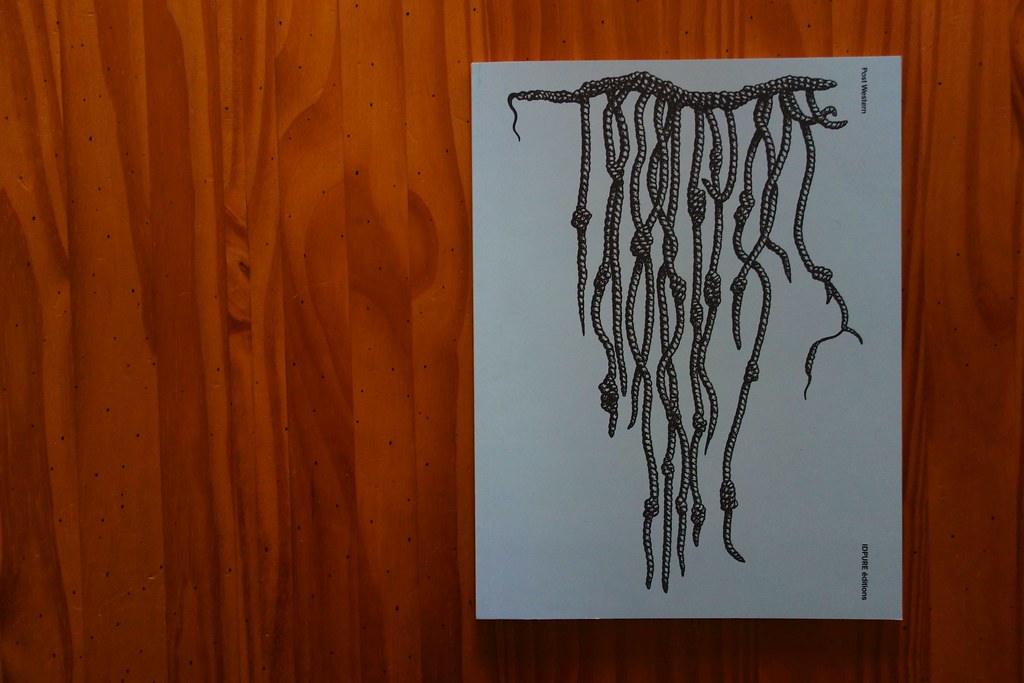
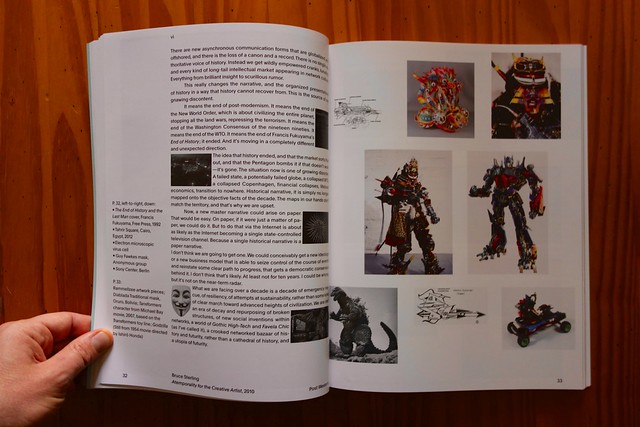



Why do I blog this? This was a good opportunity to discuss various topics and upcoming projects.
Humans and non-humans
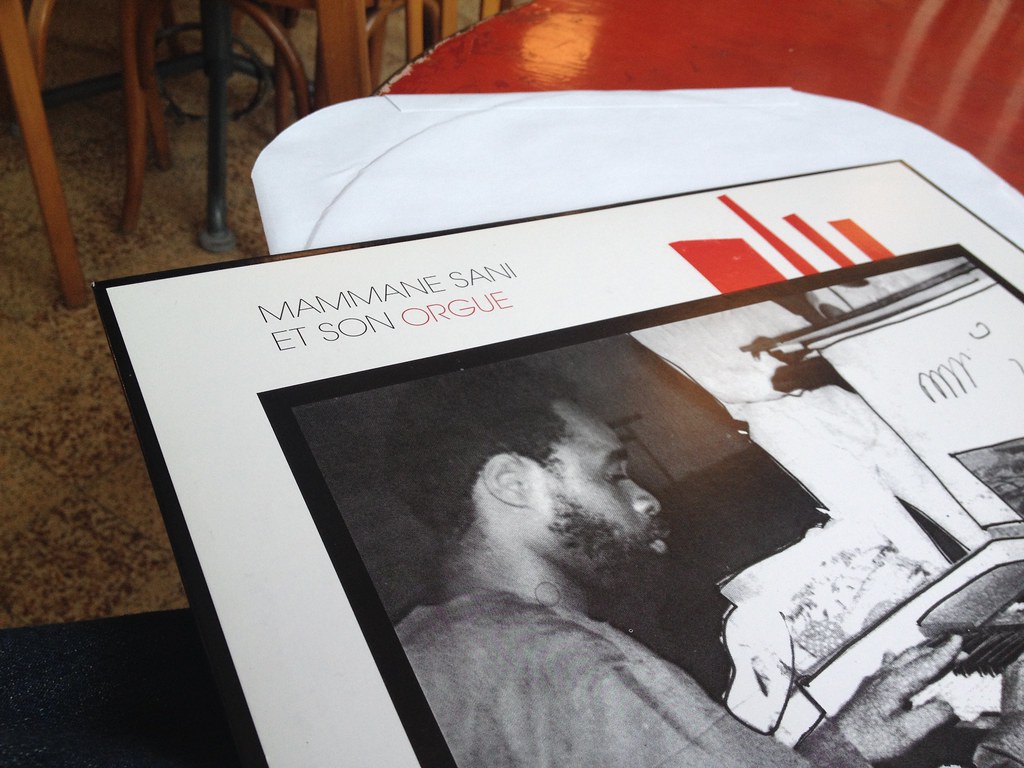 Saw that cover yesterday at Bongo Joe records, a café/record shop in Geneva. It's interesting to see that, for once, the artist AND its instrument are mentioned on the cover. "Mammane Sani et son orgue" is incredible:
Saw that cover yesterday at Bongo Joe records, a café/record shop in Geneva. It's interesting to see that, for once, the artist AND its instrument are mentioned on the cover. "Mammane Sani et son orgue" is incredible:
"Mammane Sani Abdullaye is a legendary name amongst Niger's avant garde. A pioneer of early West African electronic music, for over 30 years his instrumentals have filled the airwaves. The instrumental background drones of radio broadcasts and instrumental segue ways of TV intermissions borrow heavily from his repertoire. The dreamy organ instrumentals drift by sans comment, yet are known to all. Mammane first found the organ in 1974. "
Why do I blog this? documenting human-machine collaboration in everyday life.
The #curiousalgorithms weekly #01
This is a follow-up to my blogpost on curious algorithms. I'll try to post, on a weekly basis, some pointers to projects related with algorithms that caught my attention. It's clearly messy but these are good signals for an on-going project. Flying hacker contraption hunts other drones turns them into zombies
" "Serial hacker Samy Kamkar has released all the hardware and software specifications that hobbyists need to build an aerial drone that seeks out other drones in the air, hacks them, and turns them into a conscripted army of unmanned vehicles under the attacker's control. Dubbed SkyJack, the contraption uses a radio-controlled Parrot AR.Drone quadcopter carrying a Raspberry Pi circuit board, a small battery, and two wireless transmitters. The devices run a combination of custom software and off-the-shelf applications that seek out wireless signals of nearby Parrot drones, hijack the wireless connections used to control them, and commandeer the victims' flight-control and camera systems.""
" Disarming Corruptor, is what he terms "circumvention software". It scrambles a 3D printed file, encrypting it in such a way that the user will be greeted with a glitched-out visual treat if it is loaded into any 3D editing software. If you've got the decryption keys, you get to see the object's true form. It's hiding in plain sight, thumbing its pixel-bled nose at the Mary Whitehouses of physible culture. "
ICOMINER: PASSIVE MONETISATION
"Regardless of the solution you choose, our user visible GPU powered bitcoin miner will seamlessly integrate into your game with no interference, earning you cash in perfect harmony with your existing app monetisation strategy. There's no catch - it's just awesome."
Sites Unseen: Are CAPTCHAs Discriminatory?
"while CAPTCHA is a source of frustration for your average John or Jane User, the system can be downright prohibitive for individuals with certain disabilities. Image-only CAPTCHA systems, for example, often bar visually impaired from whatever feature the CAPTCHA is gatekeeping. This technology is so restrictive that groups are even organizing against CAPTCHA. This past summer, the Australian Communications Consumer Action Network, along with other consumer rights groups,called for an end to CAPTCHA. They requested, in no uncertain terms, that the CEOs of top companies such as Google, Microsoft, Twitter, and Facebook (among others) stop using CAPTCHA in favor of other, non-discriminatory ways of combating spam."
How Google names its algorithms
" “Boston” was the first documented update and was announced at SES Boston. The name was given by Webmaster World (WMW) members. (…) Cassandra, Dominic, Esmeralda, Fritz were also named by the folks over at WMW. The members decided that they wanted to name the updates similarly to how hurricane names are selected: in alphabetical order, one month male, one month female. Since the previous month’s update was Boston, they went with a female name and voted on Cassandra because “we just liked it.” See below why Brett Tabke, founder and owner of WMW and the PubCon conference, finalized the name. “Dominic” was actually named after a pizza place in Boston that was frequented by PubCon attendees. (…) Amit Singhal and Matt Cutts revealed that they used the code name ”Panda” to refer to the update internally. Like Vince, Panda was named after one of the key Google engineers who worked on the update and made it possible, Navneet Panda. "
Some examples of Wikipedia bots:
- User:Cydebot – generally carries out tasks associated with deletion
- User:WP 1.0 bot – works with the Version 1.0 Editorial Team
- User:SineBot – signs comments left on talk pages
- User:ClueBot NG – reverts vandalism
- User:CorenSearchBot – checks for copyright violations on new pages
- User:AnomieBOT – large variety of tasks
- User:DumbBOT – often removes protection templates from recently unprotected pages
- User:Lowercase sigmabot – often adds protection templates to recently protected pages
- User:Mr.Z-bot – will patrol BLP and the edit filters
- User:MiszaBot – archives talk pages
- User:BracketBot – notifies users of mismatched brackets in recently edited articles.
Internet time clock/watch
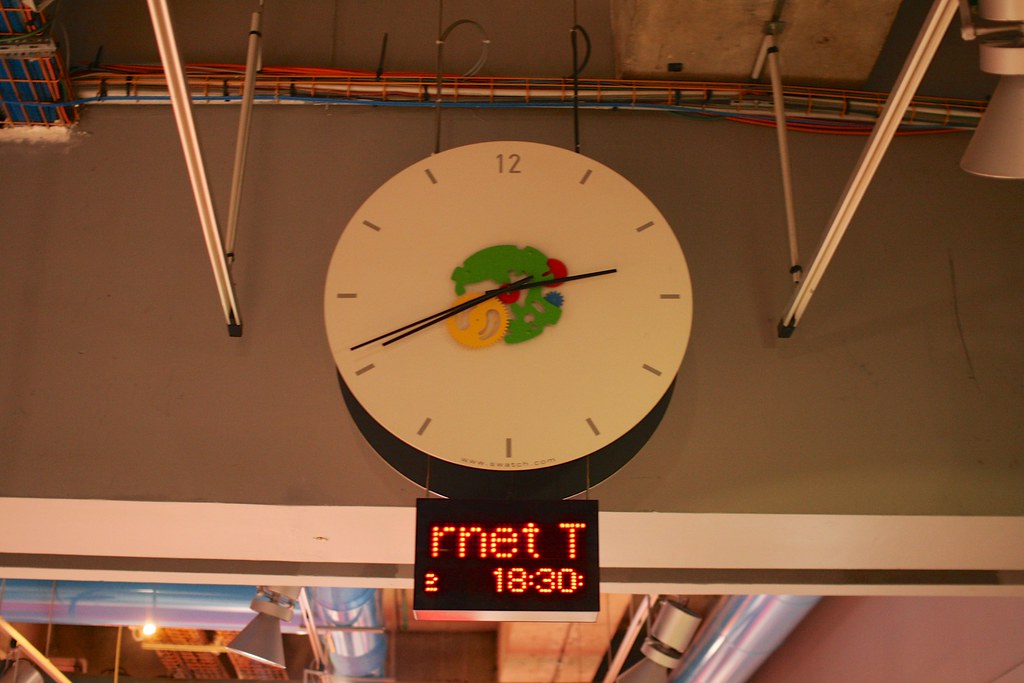 If you enter Centre Georges Pompidou, a cultural complex in the 4th arrondissement of Paris, and you wander around the basement, you may run across the clock represented on the right. The device looks rather standard, except for the colorful cogs, perhaps shown here as an echo of the high-tech architecture of the whole building. Another oddity you might notice is the LED display which gives a digital indication of the time, and a mysterious 3 digit number next to an "at" symbol.
If you enter Centre Georges Pompidou, a cultural complex in the 4th arrondissement of Paris, and you wander around the basement, you may run across the clock represented on the right. The device looks rather standard, except for the colorful cogs, perhaps shown here as an echo of the high-tech architecture of the whole building. Another oddity you might notice is the LED display which gives a digital indication of the time, and a mysterious 3 digit number next to an "at" symbol.
This combination ("@ 452") corresponds to a new way to display time, envisioned by Swatch, a Swiss watch company. The idea was to divide up the mean solar day up into 1000 parts called ".beats" (which means that a ".beat" last 26.4 seconds). Each day begins at @000 .beats, which actually corresponds to midnight in Switzerland (CET: Central European Time) and the Internet noon is thus @500 (3am in San Francisco, 6am in New York). This simply means there are no time zones, and only time scale called "Biel Mean Time" (BMT), based on the city where the company's headquarters are located.
Besides this big clock, one may find such .beats on Swatch watches as well certain cell phone models, a video game and Linux GUIs. Apart from the company website, this "new" time display is now quite uncommon, but it should not prevent us to wonder about its origin as well as its cultural implications.

According to the Wall Street Journal, the Swiss company first presented the idea for "Internet Time" back in 1998 at the MIT Medialab's Junior Summit:
"The gathering of more than ninety children aged 10 to 16 from 54 countries was organized to discuss technology's impact on the younger generation. Swatch is a major sponsor of the Lab and has been for about five years. The idea was that far-flung people would use Internet Time to coordinate their schedules and socializing"
Also, this new time standard was supposed to be used for the Nation.1 project, a conceptual country based on the Internet and owned, populated and governed by the children of the world (!).
Aside from this intriguing origin, this "internet time" based on .beats is interesting from a cultural perspective for various reasons.
First, it is important to frame this project as one of the many initiatives to measure and manage time. Over the course of history, scientific and technical discoveries have led to the design of curious apparatuses to display the "passage of time". Think about how sand, oil, candles, ropes, sticks, mechanical pieces or nuclear technologies have enabled this. It's thus not surprising to see "the Internet" as part of an assemblage devoted to measuring time. However, unlike the usage of sand or oil to measure time, the idea here is not to use the technology (network infrastructure). The point is, instead, to benefit from the sort of temporal synchronicity created by the usage of internet platforms (email, Web, etc.) and claim the importance to live in a similar timeframe. Swatch internet time was meant to get rid of time differences and have a common reference. Said differently, it's as if the Swiss company had declared local time and place irrelevant. This is all good and nice except for a fact: the "origin" .beat (@ 000) corresponds to where their headquarters are located, which is not exactly very egalitarian.
Nevertheless, even if this "internet time" sounds curious and may have looked cool, this new time format suffered from path-dependence: " how the set of decisions one faces for any given circumstance is limited by the decisions one has made in the past, even though past circumstances may no longer be relevant". This phenomenon seems always an issue when it comes to changing people's habits.
Why do I blog this? documenting the subtleties of our everyday life.
#curiousalgorithms
Being interested in the role of algorithms and their influence on everyday life, i started collecting examples under the #curiousrituals hashtag. Perhaps it's a follow-up to Curious Rituals, perhaps it isn't. Some intriguing cases I've found recently (most of them comes from the non-scientific press, as i'm focusing on everyday life):
Music generated with script and played by fake users get a good ranking on online music charts
"Melbourne hacker and payments security professional Peter Filimore, who, it should be mentioned, cannot play or sing a single note, managed to accrue $1,000 in royalties and knock artists like Pink, Nicki Minaj, and Flume off high spots in online music charts through the use of bots.
In an effort to uncover security flaws in online streaming services like Spotify, Filimore decided to send “garbage” tunes to the top of the charts and generate royalties in the process. Filimore started by using algorithms to compile public domain audio and splicing cheesy MIDI tracks together.
Filimore then purchased three Amazon-linked compute instances — virtual servers that are able to run applications — and created a simple hacking script to simulate three listeners playing his songs 24-hours a day for a month, while accruing reviews that described his music as “rubbish.” [...] Filimore also explained that using a larger cluster of computing instances could potentially generate thousands of dollars in fraudulent royalties. "
Are Face-Detection Cameras Racist?
"When Joz Wang and her brother bought their mom a Nikon Coolpix S630 digital camera for Mother's Day last year, they discovered what seemed to be a malfunction. Every time they took a portrait of each other smiling, a message flashed across the screen asking, "Did someone blink?" No one had. "I thought the camera was broken!" Wang, 33, recalls. But when her brother posed with his eyes open so wide that he looked "bug-eyed," the messages stopped.
Wang, a Taiwanese-American strategy consultant who goes by the Web handle "jozjozjoz," thought it was funny that the camera had difficulties figuring out when her family had their eyes open. So she posted a photo of the blink warning on her blog under the title, "Racist Camera! No, I did not blink... I'm just Asian!""
Bot wars - The arms race of restaurant reservations in SF
"After a while of running this script I had captured a good amount of data. One day I found myself looking at it and noticed that as soon as reservations became available on the website (at 4am), all the good times were immediately taken and were gone by 4:01am. It quickly became obvious that these were reservation bots at work. [...] You fight fire with fire, so I made my own reservation bot. You can get the code here. I used mechanize to create a simple ruby script that goes through the process of checking for available reservations (in a given time range) and making a reservation under your name. With this script I was able to start getting reservations again, but I know that this bot war will continue to escalate."
"Scans made by some Xerox copiers are changing numbers on documents, a German computer scientist has discovered. [...] He said the anomaly is caused by Jbig2, an image compression standard. Image compression is typically used to make file sizes smaller. Jbig2 would substitute figures it thought were the same, meaning similar numbers were being wrongly swapped."
Google’s autocompletion: algorithms, stereotypes and accountability
You might have come across the latest UN Women awareness campaign. Originally in print, it has been spreading online for almost two days. It shows four women, each “silenced” with a screenshot from a particular Google search and its respective suggested autocompletions. [...] Guess what was the most common reaction of people?
They headed over to Google in order to check the “veracity” of the screenshots, and test the suggested autocompletions for a search for “Women should …” and other expressions.
This awareness campaign has been very successful in making people more aware of the sexism in our world Google’s autocomplete function.
As soon as today’s students receive their proverbial fat envelope from their top choice college, they are on Facebook meeting other potential freshmen. They are on sites like roomsurf.com and roomsync.com, scoping out prospective friends. By the time the roommate application forms arrive, many like-minded students with similar backgrounds have already connected and agreed to request one another.
It’s just one of many ways in which digital technologies now spill over into non-screen-based aspects of social experience. I know certain people who can’t bear to eat in a restaurant they haven’t researched on Yelp. And Google now tailors searches to exactly what it thinks you want to find.
But this loss of randomness is particularly unfortunate for college-age students, who should be trying on new hats and getting exposed to new and different ideas. Which students end up bunking with whom may seem trivial at first glance. But research on the phenomenon of peer influence — and the influences of roommates in particular — has found that there are, in fact, long-lasting effects of whom you end up living with your first year.
Why do I blog this? I've started collecting examples like this in the past few months. Might be the beginning of something, you never know. What I find intriguing here is that there are various types of influences for such algorithms: sometimes it's a "framing" where the user's agency is limited (the racist camera for instance), sometimes it's not (you're not forced to use recommendation engines). I'm thinking about building a typology perhaps, collecting these, talking to people, there's a whole list to be built
Common misconceptions about design research
Last week I gave a two-days workshop about design research. It was part of a week-long seminar aimed at masters students from the two local design schools (HEAD–Genève and ECAL). We went through a quite intense set of activities ranging from lectures to drawing sessions, visit to the library, long arguments and exquisite corpse-like activities. My first objective was to describe what design research is, and the second to help students come up with "the research question", which looks like a Holy Grail for lots of them. We had various conversations about what research is, and how it's related to design. In doing so, lots of issues bubbled up to the surface and it was strikingly intriguing to list them. I took some notes about these and I turned it into a short presentation about the misconceptions about design research.
- Design research is what's produced when you don't have a client. It's personal project Well, this was a common perspective offered by students at the beginning. As we discussed, it seems that the way "research" is used in some of the participants' background lead them to think that we do research only when there's no problem to solve, no brief from a client. Research, in the academic sense, is about generating knowledge. What does it mean in a design context? Well, this quote by Bruce Archer express differently: “Design Research is a systematic search for and acquisition of knowledge related to design and design activity.” It's also a misconception because research projects are not done in a vacuum: there's a need to refer to the existing knowledge produced by other researchers, and funding bodies definitely influence what they want to fund. Also research can be "personal" but in general there's more than one person involved (colleagues, research partners...).
- Design research is what you do before designing a prototype, like user research for instance. The problem here is that design research is not limited to field research/ethnography. A relevant model to consider here is the one described by Christopher Frayling with the famous trichotomy of research about (e.g. history of design), for (e.g. ethnography to surface insights for design), and through design (discovering new insights/building theories based on artifact design). Design research corresponds to these three elements, but the third one is the most important... because of the relationship between theory and practice... which leads us to the third misconception:
- Design leads to artifacts (products) it doesn't produce theories. Yes, design produces artifacts but it doesn't mean that you cannot derive/generate theoretical insights based on this. The way objects are used, produced, repurposed can offer various perspectives that can be turned into different levels of theories, as showed by this quote from Alain Findeli: "due to his/her involvement in the object, the researcher will raise new questions, discover new approaches, and if he/she has talent, produce new theoretical models. I propose to call this method project-driven research". To discuss what it means practically, we used "Strong Concepts: Intermediate-Level Knowledge in Interaction Design Research" by Höök and Löwgren to discuss this. The paper describes a spectrum of knowledge one can abstract from particular design instances.
- Design research produces bad design. What designers express with this is their disappointment when they see the outcome of design research projects: artifacts which are not in line with the Zeitgeist or with tacit design criteria; and of course it's also related with certain fonts used on researchers slides, the lack of attention to certain graphic details (someone in class wondered about the 2-columns ACM template) and, above all, the fact that artifacts they see do not correspond to their level of expectations as designers (regardless of the theoretical insights produced). That's a good one as it's not so much of a misconception. There's indeed a lot of bad design outputs in design research and the community needs to do better. However, there are lots of exceptions to this and, the fact that artifacts produced by design researchers are bad does not mean that one cannot do better! As examples, we looked at various cases: Auger-Loizeau's Carnivorous Robots, Fabian Hemmert's work, as well as our own Curious Rituals.
Why do I blog this? Nothing better than a skeptical audience to learn how to frame your research topic/contribution. This seminar was highly stimulating. Plus, these misconceptions are interesting not only because there's a need to correct then. Most of them reveal how research is normative and it's sometimes good to push the boundaries a little bit!
Data science and “methodolatry”, the aestheticization and idolization of method.
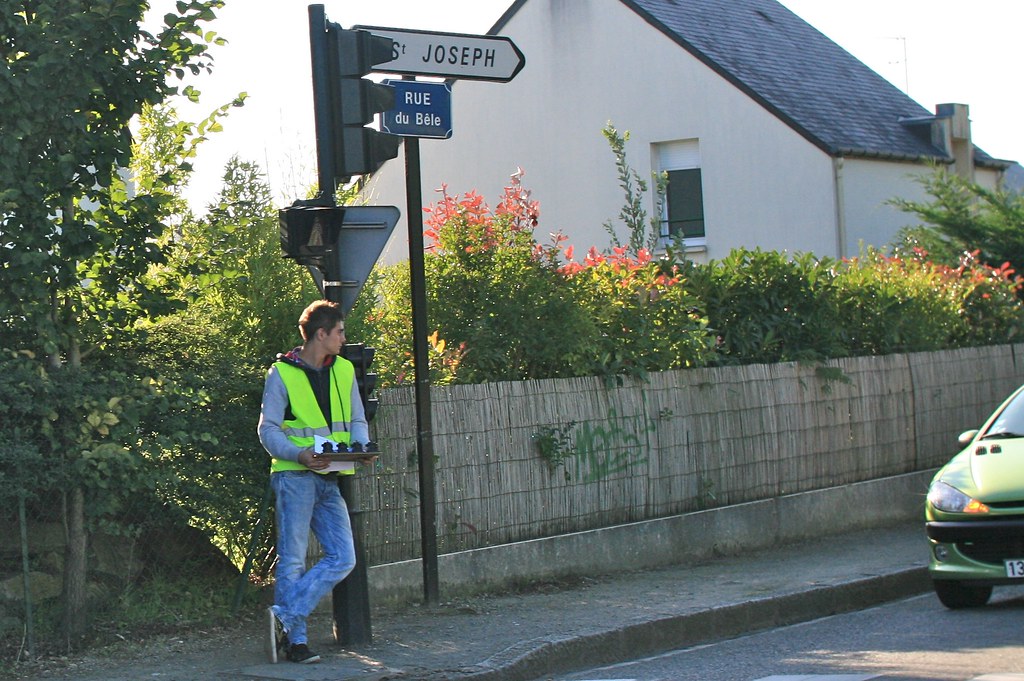 (Someone counting the number of car near a roundabout in Nantes, France)
(Someone counting the number of car near a roundabout in Nantes, France)
"Methodolatry and the Art of Measure by Shannon Mattern is an interesting piece that Jan sent me this morning. It addresses the implications of "urban data science", i.e. citizen scientists, public labs, urban explorers, infrastructural tourists generating and collecting their own data on one end of the spectrum, civic hackers on the other.
Both share the same "way of conceptualizing and operationalizing the city" and an "instrumental rationality/solutionism”... what the author calls “methodolatry,” the aestheticization and idolization of method. The author describes how the relationships between the urban environment and data with different historical pointers showing how cities are "'machine' for efficient circulation". She also refers to different claims by Lewis Munford, Friedrick Kittler and Ola Söderström which are quite relevant.
Some excerpts I found interesting:
"Is there an ethos, a value system, driving these data-generated processes, or is it all just algorithms? Of course, we wouldn’t say that there’s no ideology inherent in the algorithms themselves, but the computers powering these Big Data projects run billions of operations that cumulatively produce substantive transformations in the urban landscape, with little regard for underlying values (...) sometimes the most readily apparent or accessible way — for students in particular — to gain entry to those complex practices is to take on the aesthetics of measurement: to devise a clever data collection system, to accumulate a reassuringly big pile of data, and to massage that data into a persuasive visualization. That’s a worrisome trend. This isn’t to say that engagement with the affective or stylistic dimensions of measurement precludes engagement with its larger methodological functions; Feyerabend has shown us otherwise. Rather, I hope these concerns are brought into alignment: that the methodological packaging suits the purpose, the form serves the function, the knolling serves the knowledge. (...) perhaps these methodolatrous projects, in their aestheticization of measurement, are calling our attention to presumptions about scientific rigor, parodying our algorithmic impulses, tacitly asking questions about the ideology of a pervasive culture of measurement and assessment. Perhaps, despite their implicit alliance with CUSP and Cisco and the like, our citizen data gatherers want to highlight the “givenness,” the rhetorical nature of that data, to show its inherent irrationality, to demonstrate that the “science of cities” is also, necessarily, an art."
Why do I blog this? An interesting addition to the debates about data science and smart cities. Certainly a good complement to Adam Greenfield's "Against the Smart City".












